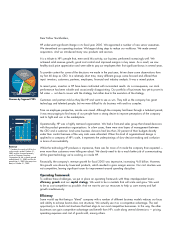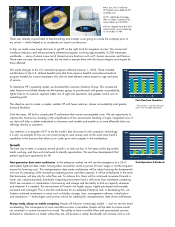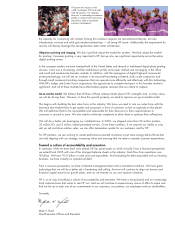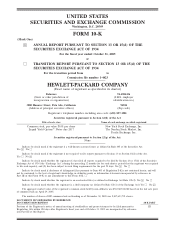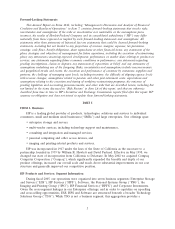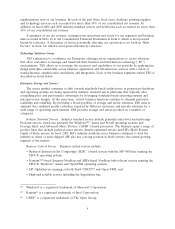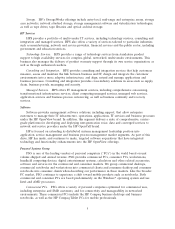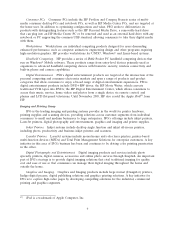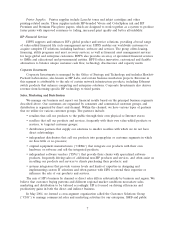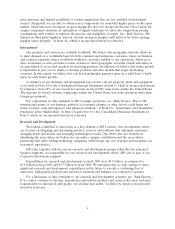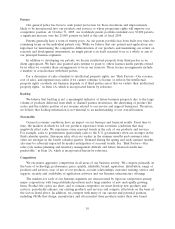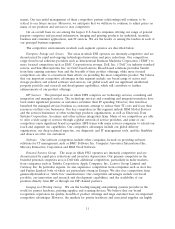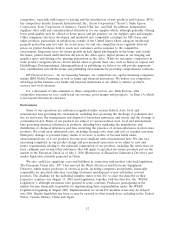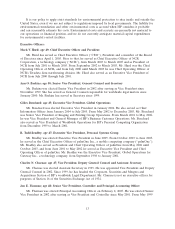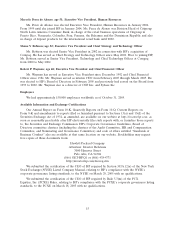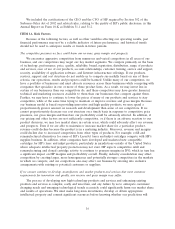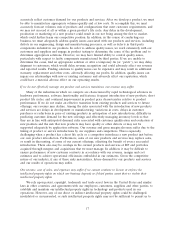HP 2005 Annual Report Download - page 12
Download and view the complete annual report
Please find page 12 of the 2005 HP annual report below. You can navigate through the pages in the report by either clicking on the pages listed below, or by using the keyword search tool below to find specific information within the annual report.sector customers. HP dissolved the CSG organization in the fourth quarter of fiscal 2005, with the
objective of reducing complexity and duplication. This decision effectively put sales and marketing
decisions and accountability back into the individual business segments. Customer segment-related sales
and marketing activities now are hosted in TSG, PSG and IPG. Notwithstanding these changes, the
concept of solution selling to different customer segments, as well as channel leverage, remains an
important element of HP’s go-to-market model.
TSG manages enterprise and public sector customer relationships and also is charged with
simplifying sales processes across our segments to improve speed and effectiveness. In this capacity,
TSG manages our direct sales for value products and pre-sales technical consultants, as well as our
direct distribution activities for commercial products and go-to-market activities with systems integrators
and ISVs.
PSG manages SMB customer relationships and commercial reseller channels, due largely to the
significant volume of commercial PCs that HP sells through these channels. In addition to commercial
channel relationships, the volume direct organization, which is charged with the management of direct
sales for volume products such as commercial PCs and industry standard servers, is hosted within PSG.
IPG manages HP’s overall consumer-related sales and marketing activities, including our annual
consumer product launch for the back-to-school and holiday seasons. IPG also manages consumer
channel relationships with approximately 20,000 third-party retail locations for imaging and printing
products, as well as other consumer products, including consumer PCs, which provides for a bundled
sale opportunity between PCs and IPG products. In addition, IPG manages direct consumer sales
through www.hp.com.
Manufacturing and Materials
We utilize a number of contract manufacturers (‘‘CMs’’) and original design manufacturers
(‘‘ODMs’’) around the world to manufacture HP-designed products. The use of CMs and ODMs is
intended to generate cost efficiencies and reduce time to market for certain HP-designed products.
Third-party OEMs manufacture some products that we purchase and resell under the HP brand. In
addition to our use of CMs and ODMs, we currently manufacture finished products from components
and sub-assemblies that we acquire from a wide range of vendors.
We utilize two primary methods of fulfilling demand for products: building products to order
(‘‘BTO’’) and configuring products to order (‘‘CTO’’). We employ BTO capabilities to maximize
manufacturing efficiencies by producing high volumes of basic product configurations. CTO permits
configuration of units to the particular hardware and software customization requirements of certain
customers. Our inventory management and distribution practices in both BTO and CTO seek to
minimize inventory holding periods by taking delivery of the inventory and manufacturing immediately
prior to the sale or distribution of products to our customers.
We purchase materials, supplies and product subassemblies from a substantial number of vendors.
For many of our products, we have existing alternate sources of supply, or such sources are readily
available. However, we do rely on sole sources for laser printer engines and parts for products with
short life cycles (although some of these sources have operations in multiple locations). We are
dependent upon Intel as a supplier of processors and Microsoft for various software products.
However, we believe that disruptions with these suppliers would result in industry-wide dislocations and
therefore would not disproportionately disadvantage us relative to our competitors. We also have a
valued relationship with AMD, and we have seen greater acceptance of AMD processors in the market
in the last year.
Like other participants in the high technology industry, we ordinarily acquire materials and
components through a combination of blanket and scheduled purchase orders to support our
requirements for periods averaging 90 to 120 days. From time to time, we have experienced significant
8


